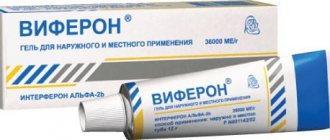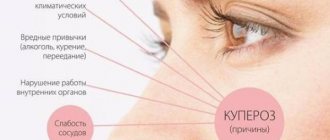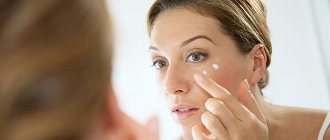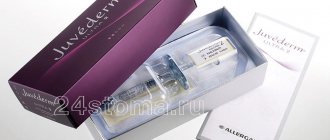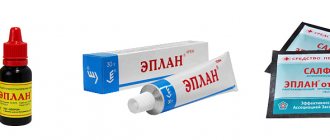How to use
Before using this or that form of the drug, you should definitely consult a specialist. You also need to do a test for the sensitivity of the skin to the constituent components in order to prevent the occurrence of allergic processes.
Ointment
The ointment is applied exclusively to damaged areas of the skin. For maximum results, apply a gauze bandage over the area. You can apply the ointment no more than 3 times a day. You can use up to 1 g of neomycin per day. The dosage for a child does not require adjustment. The duration of the therapeutic course is a week. In certain cases, the specialist may extend the treatment. When prolonging treatment, the dose used should be reduced by 2 times.
Powder
The medicine in this form is convenient to use as a powder on the umbilical wound, as well as for healing scratches. Used to treat injured skin areas. The powder can be used no more than 4 times a day. It must be applied in a thin layer. Up to 200 g of powder can be used per day. For long-term treatment, the dosage should be reduced to 100 g per day.
Baneocin
Baneocin (bacitracin + neomycin) is a combined antibiotic for external use. It is used in the treatment of focal and local skin infections caused by bacteria sensitive to the drug, as well as in the prevention of such infections in the postoperative period. Both antibacterial components included in baneocin are bactericidal, i.e. harmful to bacteria. Bacitracin is a polypeptide antibiotic that inhibits bacterial cell wall synthesis. It shows its activity against gram-positive (Staphylococcus spp., Streptococcus spp.) and a number of gram-negative “characters” of the microworld. Resistance to bacitracin develops in very rare cases. The aminoglycoside neomycin inhibits the synthesis of bacterial proteins. Acts on both gram-positive and gram-negative microorganisms. Thanks to the combination of these two antibacterial drugs, a wide spectrum of action of baneocin and its synergism against representatives of normal microflora is ensured. The pharmacologically active ingredients of baneocin are practically not absorbed from the surface of the skin (even from damaged areas), creating high concentrations precisely in the areas affected by infection. However, in case of focal infections, when the drug is applied to large areas of the skin, one should keep in mind the possibility of the drug entering the systemic circulation, which can cause generalized side effects. Baneocin is endowed with good tissue tolerance: a decrease in its activity as a result of inactivation by blood, tissue components, and other biological products is not observed.
Baneocin is available in two dosage forms: ointment and powder for external use. The ointment should be applied to the affected areas in a thin layer, taking utmost care. The frequency of use of the drug is 2-3 times a day. It is allowed to apply the ointment under an insulating bandage. Baneocin in the form of an ointment may be in demand as part of additional treatment after surgery.
The method of using the drug in the form of applying ointment to bandages can be used in the treatment of wounds and infected cavities (for example, these can be wounds or surgical incisions, healing of which is carried out by secondary intention). The principle of using baneocin powder is the same: apply a thin layer to the affected areas 2-4 times a day. For extensive burns, when at least 20% of the body surface is damaged, the powder can be used no more than 1 time per day (this is especially true for renal failure, since systemic absorption of pharmacologically active components is possible). If powder is chosen as the dosage form of baneocin for the treatment of local bacterial infections, then the daily dose of neomycin should be “fitted” into the maximum allowable 1 g, which corresponds to 200 g of powder. The duration of such a therapeutic course can be no more than 1 week. When repeating the course, the daily dose of the drug is reduced to 100 g. Any possibility of contact of the drug with the eyes should be excluded. With long-term use of baneocin in doses exceeding those specified in the instructions, due to the possible absorption of the drug into the systemic circulation, it is necessary to pay attention to the slightest signs of nephro- or ototoxic reactions. In persons with renal and hepatic insufficiency, the risk of toxic effects is higher, therefore, before and during treatment with baneocin, blood and urine patterns should be monitored (nephrotoxicity), as well as audiometric studies (ototoxicity). During long-term pharmacotherapeutic courses, it is recommended to monitor a possible increase in the number of microorganisms resistant to the action of baneocin and, if possible, prevent the uncontrolled growth of their colonies. If allergic signs or superinfection occur, the drug should be interrupted. The diuretic furosemide, when used together with baneocin, increases the risk of oto- and nephrotoxic reactions.
Contraindications and adverse reactions
You should avoid taking Baneocin in the following cases:
- increased susceptibility to constituent components;
- in case of serious skin damage, do not take the drug in the form of an ointment;
- when infected with an infection of the ear canal in the presence of perforating damage to the eardrum;
- for problems with the excretory system;
- for problems with the muscular-nervous system;
- diseases of the visual organs.
You should strictly adhere to the instructions for use and not exceed the permissible dose.
With prolonged use of the product, allergic processes may begin, accompanied by redness, itching and rashes. When treating large skin lesions, systemic negative reactions may occur.
To date, no cases of overdose with Baneocin have been recorded.
Indications and method of use
Baneocin is very widely used for infectious and inflammatory skin diseases. It has an antibacterial effect and wound healing. Has a detrimental effect on bacteria and microorganisms. Where exactly is Baneocin ointment used, and where is Baneocin powder?
- Baneocin ointment is a fatty substance that has a wide range of uses: for dry wounds, skin inflammation, cracks and postoperative sutures. Baneocin ointment in gynecology for perineal rupture. The effectiveness of Baneocin ointment doubles under a bandage.
- Baneocin powder is a dry substance that is indicated for weeping wounds and bedsores. Baneocin is also used for the navel in infants with an umbilical infection. Baneocin powder has a cooling effect.
Let's look at how to use Baneocin correctly using the example of burns.
Baneocin for burns. If the burn is fresh or if it is a weeping wound, then it is rational to treat it with Baneocin powder. Apply a thin layer to damaged tissue without touching the surface with your hands. The area of application of the drug should not cover more than 1% of the patient’s body area. Use within 7 days.
special instructions
The shelf life of the medicine in powder form is 24 months from the date of manufacture, in the form of ointment - 36 months. Store at room temperature.
If the substance gets into your eyes, rinse immediately with water.
Before taking the drug, you need to check the microflora that caused the dermatological disease for susceptibility to its constituent elements.
When taken simultaneously with other medications, you should monitor the body’s reaction, and if something happens, immediately consult a doctor.
If a person has problems with the functioning of the kidneys and liver, then he needs to constantly undergo urine and blood tests.
Popular questions about Baneocin
How to use Baneocin for the treatment of diaper rash?
When treating diaper rash, Baneocin is used both in ointment and in the form of powder. It should be applied to the baby's well-washed and dried skin. If skin redness does not go away after one use, repeat the procedure after each diaper change.
Baneocin ointment or powder - which is better?
Baneocin is a remedy that is prescribed for the treatment of infected wounds. It comes in two forms - ointment and powder. Both forms do their job well, but there are some differences. Baneocin ointment is a fatty substance that has a wide range of uses: in surgery, dermatology, gynecology, for dry wounds or skin inflammation. Baneocin powder is a dry substance that is indicated for weeping wounds (bedsores, umbilical infections in newborns).
How quickly does Baneocin work?
Baneocin has 2 effects. In the first case, the action occurs immediately after application. This is a bactericidal effect. The second effect - healing - occurs depending on various factors: the depth of the injury, the age of the patient, the degree of tissue damage. In any case, Baneocin accelerates the natural process of skin regeneration at the wound site.
How often can Baneocin be used?
The medicine must be applied to the site of injury; to enhance the effect, it can be applied under a bandage. Both adults and children should apply the medication 2-3 times a day. The treatment period is 7 days.
Analogs
There are several drugs that have a similar effect to Baneocin.
Lincomycin in the form of an ointment copes well with inflammatory processes in the skin. The composition also contains neomycin, which affects aerobic microorganisms.
Bonderm ointment is actively used for various skin diseases. Can be used by adults and children. It is also prescribed to prevent infection of sutures, cuts and wounds after surgery. In rare cases, it leads to allergic reactions and other side effects. Can be used during pregnancy and breastfeeding under medical supervision.
Baneocin®
Baneocin® is a combined antibacterial drug intended for external use.
Baneocin® contains two bactericidal antibiotics: neomycin and bacitracin, the combination of which achieves synergistic action. Bacitracin primarily inhibits the synthesis of murein in the cell wall of gram-positive bacteria (and some gram-negative bacteria).
Bacitracin is active primarily against gram-positive microorganisms: Streptococcus hemolyticus, Staphylococcus spp., Clostridium spp., Corynebacterium
diphtheriae ,
and some gram-negative microorganisms:
Neisseria spp.
and
Haemophilus influenzae.
Bacitracin is also active against
Treponema pallidum, Actinomyces spp.
and
Fusobacteria spp.
Resistance to bacitracin is extremely rare.
The effectiveness of neomycin is due in part to an increase in cell membrane permeability due to inhibition of protein synthesis. Neomycin is active against both gram-positive and gram-negative pathogens, such as Staphylococcus spp., Proteus spp., Enterobacter aerogenes, Klebsiella pneumoniae, Salmonella spp., Shigella spp., Haemophilus influenzae, Pasteurella, Neisseria meningitidis, Vibrio cholerae, Bordetella pertussis, Bacillus anthracis, Corynebacterium diphtheriae, Streptococcus faecalis, Listeria monocytogenes, Escherichia coli
and
Mycobacterium tuberculosis.
Also active against
Borrelia
and
Leptospira interrogans (L. icterohaemorrhagiae).
Some strains of staphylococci are resistant to neomycin.
Thanks to the use of a combination of these two substances, a wide spectrum of action of the drug is achieved, with the exception of action against pseudomonas, nocardia, fungi and viruses. Tissue tolerance of the drug Baneocin® is assessed as good; inactivation by biological products, blood and tissue components is not observed.
If the drug is applied to large areas of skin lesions (in violation of the recommended dosage regimen), the possibility of absorption of the drug and its consequences should be taken into account (see sections “Contraindications”, Interaction with other drugs”, “Special instructions” and “Side effects”) .
Baneocin® powder also has a drying, soothing and cooling effect.
Note!
The description of the drug Baneocin on this page is a simplified author’s version of the apteka911 website, created on the basis of the instructions for use.
Before purchasing or using the drug, you should consult your doctor and read the manufacturer's original instructions (attached to each package of the drug). Information about the drug is provided for informational purposes only and should not be used as a guide to self-medication. Only a doctor can decide to prescribe the drug, as well as determine the dose and methods of its use.


